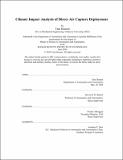Climate Impact Analysis of Direct Air Capture Deployment
Author(s)
Housen, Tara
DownloadThesis PDF (6.952Mb)
Advisor
Barrett, Steven R. H.
Allroggen, Florian
Terms of use
Metadata
Show full item recordAbstract
Direct air capture (DAC) is a negative emissions technology (NET) that can contribute to mitigating climate change impacts by extracting CO₂ from the atmosphere. Given its low technical maturity, uncertainties persist regarding DAC's cost, scalability, and life-cycle emissions. In this analysis I assess liquid and solid DAC technologies powered by various energy sources to provide insights into its current and future economic viability and its net GHG emissions impact. My findings show electric DAC configurations relying on renewable electricity have high carbon removal efficiency and relatively low cost. Additionally, I quantify the climate impact of large-scale global DAC deployment with investments of 0.5%, 1%, 1.5%, and 2% of the global GDP. I integrate electric DAC plants powered by renewable energy with co-located CO₂ storage sites. This analysis reveals that for scenarios with high anthropogenic emissions, DAC investments of up to 2% of global GDP cannot stabilize CO₂ concentrations. The results indicate that the 1.5°C goal can be achieved with an investment of 1.5% of the global GDP if cumulative emissions remain within 1178 GtCO₂; or with an investment of 0.5% of the global GDP if cumulative emissions remain within 981 GtCO₂. Alternatively, the 2°C goal can be achieved with an investment of 1.5% of the global GDP if cumulative emissions remain within 2750 GtCO₂; or with an investment of 0.5% of the global GDP if cumulative emissions remain within 1178 GtCO₂.
Date issued
2024-05Department
Massachusetts Institute of Technology. Department of Aeronautics and AstronauticsPublisher
Massachusetts Institute of Technology